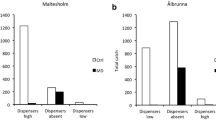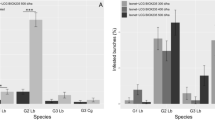Abstract
A novel emulsified wax dispenser (SPLAT-OFM) of pheromone was evaluated in concert with a custom-built, tractor-mounted applicator, designed for fast application of dispensers for mating disruption of Oriental fruit moth, Grapholita molesta (Busck), in apple. The formulation consisted of microcrystalline wax emulsified in water. It was loaded with G. molesta pheromone (93:6:1 blend of (Z)-8-dodecen-1-yl-acetate:(E)-8-dodecen-1-yl-acetate:(Z)-8-dodecen-1-ol) at 10% by weight. The hydraulically driven applicator dispensed the wax formulation as discrete particles from a rotating double-orifice distributor positioned directly above the tree canopy. Wax-drop size averaged (±SEM) 0.38 ± 0.16 g and 4.3 ± 0.5 drops adhered per tree. Following a single mechanized application of SPLAT-OFM on 24 April at 8 ml per tree (1.6 kg/ha) to 0.8 ha blocks of apple, male G. molesta orientation to optimally attractive pheromone traps was disrupted by 98% relative to untreated control plots for the whole season. Furthermore, on 17 weekly deployments of tethered virgin females (1,016 females deployed and 732 recovered for dissection) throughout the season, no mating was detected in SPLAT-OFM-treated blocks, while mating in control blocks averaged 27%. During the first 17 days following deployment in sticky traps, SPLAT-OFM drops attracted ca. 1/46th of the number of male G. molesta attracted to optimized synthetic lures. However, following 17 days of field aging, SPLAT-OFM drops became equally attractive to optimized synthetic lures for the remainder of the season. The release rate of pheromone from wax drops 0–14 and 15–76 days following deployment averaged 21.4 and 5.3 μg/h, respectively. The trapping and release rate data were consistent with competitive attraction as the mechanism mediating disruption. Shoot injury following the first moth generation was sevenfold less in SPLAT-OFM treated blocks compared with controls and fruit injury at the end of the season in treated blocks was approximately half of that recorded in controls.



Similar content being viewed by others
References
Atanassov A, Shearer PW, Hamilton G, Polk D (2002) Development and implementation of a reduced risk peach arthropod management program in New Jersey. J Econ Entomol 95:803–812
Atterholt CA (1996) Controlled release of insect sex pheromones from sprayable, biodegradable materials for mating disruption. Ph.D. dissertation. University of California at Davis, Davis, CA
Atterholt CA, Delwiche MJ, Rice RE, Krochta JM (1998) Study of biopolymers and paraffin as potential controlled-release carriers for insect pheromones. J Agric Food Chem 46:4429–4434
Audemard H, Leblon C, Neumann U, Marboutie G (1989) Bilan de sept années d’essais de lutte contre la Tordeuse orientale du pêcher Cydia molesta Busck (Lep., Tortricidae) par confusion sexuelle des mâles. J Appl Entomol 108:191–207
Baker TC, Roelofs WL (1981) Initiation and termination of Oriental fruit moth male response to pheromone concentrations in the field. Environ Entomol 10:211–218
Baker TC, Cardé RT, Miller JR (1980) Oriental fruit moth pheromone component emission rates measured after collection by glass-surface adsorption. J Chem Ecol 6:749–758
Cardé RT, Baker TC, Roelofs WL (1975) Ethological function of components of a sex attractant system for Oriental fruit moth males, Grapholita molesta (Lepidoptera: Tortricidae). J Chem Ecol 1:475–491
Cardé RT, Baker TC, Castrovillo PJ (1977) Disruption of sexual communication in Laspeyresia pomonella (codling moth), Grapholitha molesta (oriental fruit moth) and G. prunivora (lesser appleworm) with hollow fiber attractant sources. Entomol Ex Appl 22:280–288
Charlton CE, Cardé RT (1981) Comparing the effectiveness of sexual communication disruption in the oriental fruit moth (Grapholita molesta) using different combinations and dosages of its pheromone blend. J Chem Ecol 7:501–508
de Lame FM (2003) Improving mating disruption programs for the Oriental fruit moth, Grapholita molesta (Busck): efficacy of new wax-based formulations and effects of dispenser application height and density. M.S. thesis, Michigan State University, 172 pp
Epstein DL, Stelinski LL, Reed TR, Miller JR, Gut LJ (2006) Higher densities of distributed pheromone sources provide disruption of codling moth, (Lepidoptera: Tortricidae) superior to that of lower densities of clumped sources. J Econ Entomol 99:1327–1333
Giroux PY, Miller JR (2001) Phytotoxicity of pheromonal chemicals to fruit tree foliage: chemical and physiological characterization. J Econ Entomol 94:1170–1176
Gut LJ, Stelinski LL, Thompson DR, Miller JR (2004) Behavior modifying chemicals: prospects and constraints in IPM. In: Koul O, Dhaliwal GS, Cuperus G (eds) Integrated pest management: potential, constraints, and challenges. CABI Press, Wallingford, UK, pp 73–121
Il’ichev AL, Williams DG, Milner AD (2004) Mating disruption barriers in pome fruit for improved control of oriental fruit moth Grapholita molesta Busck (Lep., Tortricidae) in stone fruit under mating disruption. J Appl Entomol 128:126–132
Il’ichev AL, Stelinski LL, Williams DG, Gut LJ (2006) Sprayable microencapsulated sex pheromone formulation for mating disruption of oriental fruit moth (Lepidoptera: Tortricidae) in Australian peach and pear orchards. J Econ Entomol 99:2048–2054
Kanga LHB, Pree DJ, van Lier JL, Walker GM (2003) Management of insecticide resistance in Oriental fruit moth (Grapholita molesta; Lepidoptera: Tortricidae) populations from Ontario. Pest Manage Sci 59:921–927
Kovanci OB, Schal C, Walgenbach JF, Kennedy GG (2005) Comparison of mating disruption with pesticides for management of Oriental fruit moth (Lepidoptera: Tortricidae) in North Carolina apple orchards. J Econ Entomol 98:1248–1258
Knight AL, Larsen TE, Ketner KC (2004) Rainfastness of a microencapsulated sex pheromone formulation for codling moth (Lepidoptera: Tortricidae). J Econ Entomol 97:1987–1992
Meissner HE, Atterholt CA, Walgenbach JF, Kennedy GG (2000) Comparison of pheromone application rates, point source densities, and dispensing methods for mating disruption of tufted apple bud moth (Lepidoptera: Tortricidae). J Econ Entomol 93:820–827
McNair HM, Miller JM (1998) Basic gas chromatography. Wiley, New York
Miller JR, Gut LJ, de Lame FM, Stelinski LL (2006a) Differentiation of competitive vs. non-competitive mechanisms mediating disruption of moth sexual communication by point sources of sex pheromone: (Part 1) theory. J Chem Ecol 32:2089–2114
Miller JR, Gut LJ, de Lame FM, Stelinski LL (2006b) Differentiation of competitive vs. non-competitive mechanisms mediating disruption of moth sexual communication by point sources of sex pheromone: (Part 2) case studies. J Chem Ecol 32:2115–2143
Millar JG (1995) Degradation and stabilization of (E,E)-8,10-dodecadien-1-ol, the major component of the sex pheromone of the codling moth (Lepidoptera: Tortricidae). J Econ Entomol 88:1425–1432
Myers CT, Hull LA, Krawczyk G (2006) Seasonal and cultivar associated variation in oviposition preference of Oriental fruit moth (Lepidoptera: Tortricidae) adults and feeding behavior of neonate larvae in apples. J Econ Entomol 99:349–358
Palaniswamy P, Robs RJ, Seebrook WD, Lonergan GC, Weisner CJ, Tan SH, Silk PJ (1982) Mating suppression of caged spruce budworm (Lepidoptera: Tortricidae) moths in different pheromone atmospheres and high population densities. J Econ Entomol 75:989–993
Pfeiffer DG, Killian JC (1988) Disruption of olfactory communication in oriental fruit moth and lesser appleworm in a Virginia peach orchard. J Agric Entomol 5:235–239
Pree DJ, Trimble RM, Whitty KJ, Vickers PM (1994) Control of oriental fruit moth by mating disruption using sex pheromone in the Niagara Peninsula, Ontario. Can Entomol 126:1287–1299
Rice RE, Kirsch P (1990) Mating disruption of oriental fruit moth in the United States. In: Ridgway RL, Silverstein RM, Inscoe MN (eds) Behavior-modifying chemicals for insect management. Marcel Dekker, New York, pp 193–211
Rice RE, Atterholt CA, Delwiche MJ, Jones RA (1997) Efficacy of mating disruption pheromones in paraffin emulsion dispensers. IOBS WPRS Bull 20:151–161
Rothschild GLH, Vickers RA (1991) Biology, ecology and control of the Oriental fruit moth. In: Van Der Geest LPS, Evenhuis HH (eds) Tortricid pests: their biology, natural enemies and control. Elsevier, New York, pp 389–412
SAS Institute (2000) SAS/STAT User’s Guide, version 6, 4th edn, vol 1. SAS Institute, Cary, NC
Stelinski LL, Gut LJ, Pierzchala AV, Miller JR (2004) Field observations quantifying attraction of four tortricid moth species to high-dosage, polyethylene-tube pheromone dispensers in untreated and pheromone-treated orchards. Entomol Exp Appl 113:187–196
Stelinski LL, Gut LJ, Mallinger RE, Epstein DL, Reed TP, Miller JR (2005) Small plot trials documenting effective mating disruption of Oriental fruit Moth by using high densities of wax-drop pheromone dispensers. J Econ Entomol 98:1267–1274
Stelinski LL, Miller JR, Ledebuhr R, Gut LJ (2006) Mechanized applicator for large-scale field deployment of paraffin-wax dispensers of pheromone for mating disruption in tree fruit. J Econ Entomol 99:1705–1710
Suckling DM, Karg G, Bradley SJ, Howard CR (1994) Field electro-antennogram and behavioral responses of Epiphyas postvittana under low pheromone and inhibitor concentration. J Agric Entomol 87:1477–1487
Trimble RM, Pree DJ, Carter NJ (2001) Integrated control of oriental fruit moth (Lepidoptera: Tortricidae) in peach orchards using insecticide and mating disruption. J Econ Entomol 94:276–285
Trimble RM, Pree DJ, Barszcz ES, Carter NJ (2004) Comparison of a sprayable pheromone formulation and two hand-applied pheromone dispensers for use in the integrated control of Oriental fruit moth (Lepidoptera: Tortricidae). J Econ Entomol 97:482–489
Waldstein DE, Gut LJ (2004) Effects of rain and sunlight on Oriental fruit moth (Lepidoptera: Tortricidae) pheromone microcapsules applied to apple foliage. J Agric Urban Entomol 21:117–128
Acknowledgments
We thank Krista Buehrer and Elizabeth Steere for diligent maintenance of insect colonies and for assistance with trap maintenance and tethering of female moths. We are very grateful to Bill Erwin for allowing us to use his orchards as experimental sites and for his help in pruning and mowing unmanaged portions of his orchards free of charge.
Author information
Authors and Affiliations
Corresponding author
Rights and permissions
About this article
Cite this article
Stelinski, L.L., Miller, J.R., Ledebuhr, R. et al. Season-long mating disruption of Grapholita molesta (Lepidoptera: Tortricidae) by one machine application of pheromone in wax drops (SPLAT-OFM). J Pest Sci 80, 109–117 (2007). https://doi.org/10.1007/s10340-007-0162-0
Received:
Revised:
Accepted:
Published:
Issue Date:
DOI: https://doi.org/10.1007/s10340-007-0162-0




